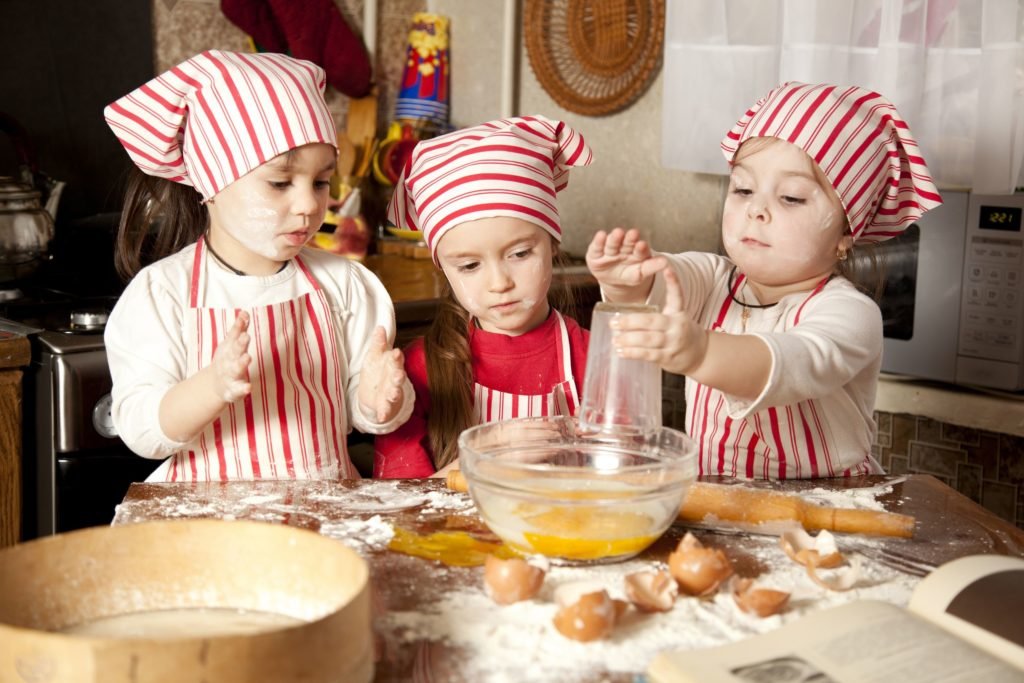One of the most valuable experiences for raising a healthy child on the spectrum is spending time in the kitchen. Parents often are disbelieving when hearing this. It sounds like a lot of mess. And is it safe? Yes, with proper preparation, cooking with your child is safe. And, yes, it will probably be messy. It’s also much more than that.
Kids with autism are more likely than their peers to have food aversions, which leads to a poor quality diet. Inviting children into the kitchen to experience various textures and temperatures is often the first step to eventually tasting something new. Research shows that children are more likely to eat a meal when they are involved in its preparation and that children who are exposed to food outside of meal times tend to have diverse diets.
The benefits of cooking extend beyond diet. Cooking is a valuable life skill that fosters confidence and independence. Being in the kitchen with others can improve communication and social skills. Following a recipe teaches reading, listening, math, and sequencing. Learning to prepare food can promote sensory integration and focus. Finally, many parents find that cooking with their child is a gratifying opportunity for connection. Even with its benefits, the concept of inviting a child with autism into the kitchen can be daunting. Follow these tips to bring your child into the kitchen with ease and confidence.
Prepare for Sensory Challenges

Preparing food engages all of the senses, which can overwhelm many children with autism. If children are hesitant to engage with food due to sensory or any other aversions, have them begin their journey in the kitchen by participating in non-food activities such as organizing kitchen items, identifying tools, or measuring using spoons and scales. When your child is handling food in the kitchen, consider some of the following adaptations to accommodate his/her needs:
If your child is sensitive to noise:
- Use rubber utensils and plastic bowls, which clang less than metal ones
- Select recipes that don’t require noisy appliances
- Allow comforting headphones or play soothing music
- Avoid stove-top recipes that may sizzle and pop
If your child is sensitive to scent:
- Begin with recipes like salad dressings, dips, or sandwiches that don’t require using heat
- Try baking projects that allow your child to mix dough or batter and leave the kitchen during baking
If your child is sensitive to tactile experiences:
- Offer thin medical gloves for handling food
- Stash a cloth or towel nearby to wipe dirty hands
- Provide long utensils that give him/her a safe distance from food
If your child is sensitive to light:
- Adjust the lighting so it’s comfortable
- Be aware of any blinking clocks or bright lights from electronics
Start Simply

When beginning, opt for easy tasks that spark your child’s interests and use his/her strengths. Some fun introductory activities include tearing herbs, washing produce and dishes, organizing spice jars, collecting ingredients, smelling new foods, measuring, lining muffin tins, arranging cookies on a tray, and pressing buttons on the blender.
Incorporate Routines
Children on the spectrum tend to love routines. Knowing what to expect can make a new activity feel more comfortable. Maintain a similar structure every time you’re in the kitchen together. For example, begin every cooking session by washing hands and end with a tasting.
Rethink Recipes
Processing a recipe can be a challenge, but language and sequencing skills should not prevent you from inviting your child into the kitchen. Seek recipes like pesto or salads that require only a few simple steps. If your child is visual, create picture instructions or a visual schedule.
Taste as you Go
Tasting is part of cooking. I suggest keeping tiny tasting spoons within reach for small tastes. Take the emphasis away from the fact that your child might be trying something new and instead focus on making the recipe taste delicious. Sampling and adjusting seasoning until the food tastes right is a wonderful opportunity to explore new language and flavors while establishing a positive relationship with food.
Make Food Fun
Get creative with food-focused activities. Design a personal pizza pie. Bring your child shopping. At the store, point out all of the round fruits you see and maybe find one to bring home. Play games: host a contest to see who can shell the most peas or tear green bean stems fastest. Get crafty making your own potato head using leftover veggie scraps or creating stamps from hardy fruits and vegetables. While these activities may seem unrelated to eating, repeated positive experiences with food will lead to tasting.
Think Outside the Oven

The increased likelihood that a child will taste the foods he/she helps prepare is one of the most gratifying outcomes of including a child in food preparation. However, the kitchen doesn’t have to be the only place where a positive relationship with food begins. Expand the story about food by taking your child to the market where he/she can select a new vegetable to bring home. Plant a garden or a few pots of herbs to keep by the window. Visit a farm where food is grown or take a trip to the local library where you can explore cookbooks. Any exposure to new foods is a step towards becoming someone comfortable with food.
Make Room in Meal Prep
It may feel natural to incorporate your child into kitchen activities that you are already planning, such as preparing lunch or dinner. Packing lunch is often a safe opportunity for even the most kitchen-averse kids. Parents I work with have found success in inviting their child to build his/her lunch by picking items from a bin filled with pre-selected lunch options. Consider assigning your child a nightly dinner task like mixing a jar of homemade salad dressing or counting out the number of tortillas needed for taco night.
Just get Started
Cooking with your child is more about the experience than the final product. As you continue to include your child in the kitchen, you’ll learn what works well and what doesn’t need to be repeated. Even if at first you are left with a huge mess or your child won’t stay put for a whole activity, your efforts are not futile. As with all things, bringing your child into the kitchen can take time. Find activities that help your child connect. Play to strengths—keep things simple and fun. And, remember, the benefits you see might go way beyond your vision.



